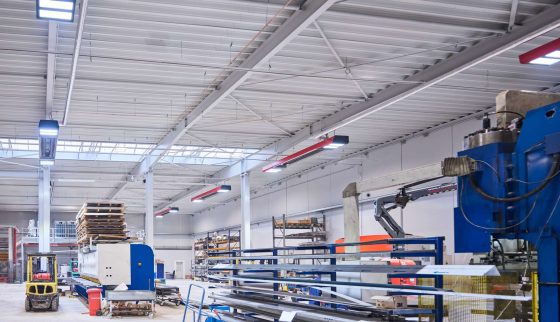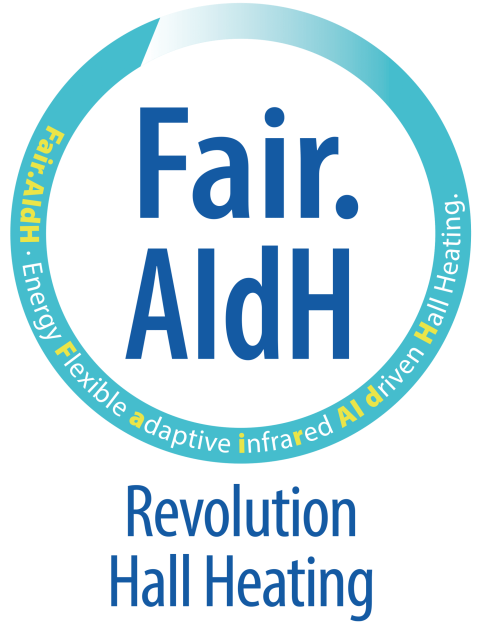Infrared hall heating in your production: How to create the right indoor climate for your production

Hall buildings are a world of their own. Particularly in winter, their high ceilings pose a real challenge for anyone who wants to ensure the most pleasant working environment possible in the workplace. But there are solutions - for example, infraredHall heating. But first you should ask yourself: What does a pleasant indoor climate actually mean? And which factors are decisive for this? There are various explanations that basically boil down to four different factors, which we will explain to you in this guide.
4 factors that influence a pleasant indoor climate at the workplace
Basically, when it comes to a pleasant indoor climate in the workplace, you should always pay attention to these four factors:
- Temperature
- Air humidity
- Air movement
- Air quality
While the temperature is highly dependent on the type of activity (18 °C is sufficient for physical work, at least 20 °C is required when sitting), there is a consensus on the factors of humidity, air movement and air quality. 40 - 60 % humidity, air movement of no more than 0.15 m/s (at 21 °C) and an oxygen content of 21 % are guideline values that most people find pleasant and therefore constitute the optimum indoor climate at the workplace.
The right indoor climate at the workplace influences the productivity of your employees
Dass sich ein schlechtes Raumklima am Arbeitsplatz negativ auf die Leistungsbereitschaft und -fähigkeit Ihrer Mitarbeiter auswirkt, ist erwiesen. Sie merken es spätestens, wenn Beschwerden eingehen oder der Krankenstand ansteigt. Neben vielen anderen Stellen hat sich die Bundesanstalt für Arbeitsschutz und Arbeitsmedizin (baua) damit beschäftigt und schreibt dazu in einem Bericht:
"Minor deviations from the "optimum climate" initially lead to discomfort, resulting in complaints about the climate (too hot, too cold, draughts). If these effects intensify and climate monotony or the inability to influence the climate yourself is added to this, this can lead to a high level of dissatisfaction, stress and psychological strain; motivation and satisfaction with one's own work decrease. Ultimately, the willingness to make an effort decreases, employees feel less productive and objectively measurable productivity losses and increased error rates can occur."
The problems you encounter when you want to create the optimum indoor climate in the workplace
Hall buildings are not easy to heat. Because the rooms are particularly large and high, it can also be particularly challenging to achieve the ideal indoor climate in the workplace. Find out below what problems arise when choosing a hall heating system.
Problem 1: The size of hall buildings as the biggest challenge for the indoor climate in the workplace
It is still relatively easy to positively influence the indoor climate in offices. However, if the workplace is a production hall, those responsible face completely different challenges. This is because the corporate goal of a "good working environment" faces headwinds from various directions:
- Large ceiling heights from 4 to 20 meters and more
- Long gate opening times
- Various work areas and hall zones
- Different building floor plans and layouts
- Dynamic temperature requirements
- Insufficient insulation, especially in old halls
- High pressure to reduce operating costs
- Gesetzliche Vorschriften zur Dekarbonisierung
Creating the optimum indoor climate in the workplace is therefore anything but easy in a production hall. Just keeping the temperature in such a building at a comfortable level is no trivial matter. Particularly because good and even heating is also important against the background of the Energy efficiency must be considered. Not to mention humidity, air movement and air quality.
Problem 2: Not every heating system contributes to a good indoor climate at the workplace
To the Hall heating werden die unterschiedlichsten Technologien genutzt. Nicht immer mit dem gewünschten Ergebnis was Funktionalität, Wärmekomfort und Wirtschaftlichkeit betrifft. Sie unterscheiden sich nach Art des Energieträgers (Heizöl, Gas, Holz, Strom, Sonne) und nach Art der Bereitstellung: zentral oder dezentral. Dezentral beheizte Systeme sind heute in vielen Anwendungsbereichen die Technologie der Wahl. Dabei nehmen insbesondere gasbetriebene Infrarot-Hallenheizungen des Typs Dunkelstrahler eine herausragende Rolle ein, weil sie speziell für die Beheizung hoher Räume zugeschnitten sind und dort wichtige Vorteile bieten. Vorteile, die auch die neue Generation Infrarot-Hallenheizungen der neuen Fair.AIdH*-Technologie bieten. Nur dass diese zusätzlich effektiv als 2in1-System mit integrierter LED-Hallenbeleuchtung eingesetzt werden können und – noch wichtiger – energieflexibel und regenerativ mit Strom oder Wasserstoff betreibbar sind.
* Fair.AIdH* steht für die neue energieflexible Heizungstechnologie zur Dekarbonisierung von Hallengebäuden. Die Abkürzung bedeutet: Energy Flexible, adaptive, infrared, AI driven Hall Heating.
No hot air: Why infrared indoor heaters are so good for the indoor climate in the workplace
Infrared hall heaters are Radiant heaters. These heating systems transfer heat by emitting infrared radiation. As soon as the rays hit bodies or objects, they are converted into heat. The effect of infrared hall heaters is therefore similar to the heat principle of the sun, which does not heat the air but directly heats people, room frames, machines and other objects in the hall, resulting in a particularly pleasant indoor climate in the workplace.
Radiant heaters also have the decisive advantage in high rooms: where no air is heated, no warm air can rise high under the hall roof and form unused warm air cushions there - outside the working area. Infrared hall heaters are specially designed to bring heat evenly into the area of use. And nowhere else. Incidentally, this is also the key reason why these systems are so energy-saving and therefore so economical and environmentally friendly.
Infrared indoor heaters influence an optimal indoor climate in the workplace in many different ways
Die gleichmäßige gezielte Temperaturführung ist nicht der einzige Grund, warum Infrarot-Hallenheizungen für ein angenehmes Raumklima am Arbeitsplatz sorgen. Dadurch, dass keine Warmluft entsteht, verursachen diese Systeme keine unangenehmen Zugerscheinungen – und wo keine Zugluft ist, gibt es keine Staubaufwirbelungen, die die Luftqualität belasten könnten. Staub ist fast überall – daher ist dies ein wichtiger Pluspunkt für das Wohlgefühl und die Gesundheit Ihrer Mitarbeiter ebenso wie für den Schutz Ihrer Produktionsmaschinen. Ein Vorteil für die Luftqualität ist auch die geschlossene Verbrennung des besonderen Typs Infrarot-Hallenheizung – und damit verbunden ihre Eigenschaft, dass Abluft gezielt nach außen abgeführt wird und nicht im Hallengebäude verbleibt. So lässt sich diese Waste heat incidentally - increasing efficiency - for other thermal processes, e.g. for hot water preparation (keyword: hybrid systems).
How to specifically control a good indoor climate at the workplace with an infrared indoor heating system
Infrarot-Hallenheizungen wie die Technologien von KÜBLER sind heute nur noch selten einfache Stand-alone-Lösungen. Sie sind digital in Systeme eingebunden, die eine Vielzahl smarter Funktionen ermöglichen. So lassen sich in den Hallen verschiedene Nutzungsbereiche definieren, gezielt ansteuern und bedarfsgerecht temperieren (Stichwort: Zonenbeheizung). Intelligente Effizienzmodule erkennen z. B. offene Hallentore und schalten die Heizung automatisch ab, bis die Tore wieder geschlossen werden. Je nach Länge der Toröffnungszeiten lassen sich so nennenswerte Energieeinsparungen erzielen. Ein- und Abschaltzeiten werden heute digital optimiert und gesamte Heizprozesse im Monitoring überwacht und für Audits z. B. nach DIN EN ISO 50001 analysiert. Ebenso lässt sich auch die Luftfeuchtigkeit regeln – das ist sinnvoll, wenn Sie z. B. korrosionsempfindliche Waren wie Coils lagern.
Create a pleasant indoor climate in the workplace with KÜBLER infrared indoor heaters
Mit Infrarot-Hallenheizungen lassen sich die vielfältigen klimatischen Herausforderungen von Hallengebäuden lösen – schließlich sind sie speziell für diesen besonderen Anwendungsfall entwickelt worden und steuern so einen großen Teil zu einem angenehmen Arbeitsklima am Arbeitsplatz bei. Doch sie sind mehr als die Grundlage für ein gutes und produktives Raumklima am Arbeitsplatz. Vielmehr sind Infrarot-Hallenheizungen heute darauf ausgelegt, in Ihre Halle ein Maximum an Energieeffizienz zu bringen – und damit an Kostensenkung und CO₂-Reduktion. Auch die neuen energieflexiblen Fair.AIdH*-Systeme sind digitale Hochleistungslösungen, die den Verbrauch ganz gleich welcher Energie so niedrig halten, dass sie sich ökologisch wie ökonomisch bezahlt machen. Durch skalierbare CO₂-Reduktion (bis 100 % CO₂-frei), günstige Betriebskosten und niedrige TCO (Total Costs of Ownership). Deshalb zählen sie heute zu den zentralen Bausteinen einer nachhaltigen Finanz- und Unternehmensstrategie.
If you are also interested in a hall heating system that not only creates an ideal indoor climate in the workplace, but is also environmentally friendly, you should take a look at our KÜBLER infrared hall heating systems. With our heating systems, you are not only making the right choice for your employees, but also for the future of the planet.
-
According to the IMD Competiveness Ranking 2024[1], our once leading industrial nation has slipped from 6th to 24th place in just ten years. 45 percent of industrial companies with high electricity costs are planning or implementing plans to reduce their production or relocate it abroad. And the trend is rising[2]. Increasing bureaucratic costs and the extremely high level of energy prices in our country are causing many companies to [...]
-
High sickness rates are a burden for many companies. Many companies have discovered that this is not only dependent on the time of year and the incidence of infection, but can also be directly influenced. They are actively working to improve employee satisfaction and are developing suitable programs to increase this important factor.
-
Whether in industry or in private residential construction - anyone deciding on a heating system or hall heating of the future today is faced with a lot of question marks. Which energy scenarios will actually determine the future? Which technologies will then become relevant? Is it still worth investing in fossil-fuel systems? What does the traffic light say? And taking all these questions into account, what is the best functional and economical heating solution for the hall building in the long term?
-
The new CO₂ tax came into force in 2021. It is intended to help Germany achieve its climate protection targets. Read on to find out what this means for your company in terms of costs and what you should do now!





